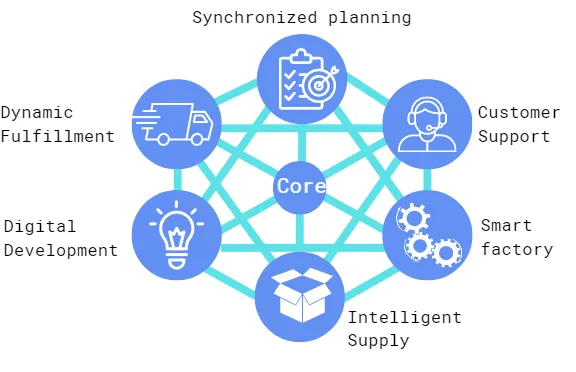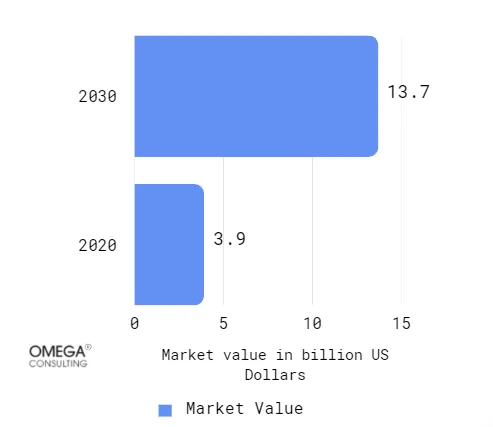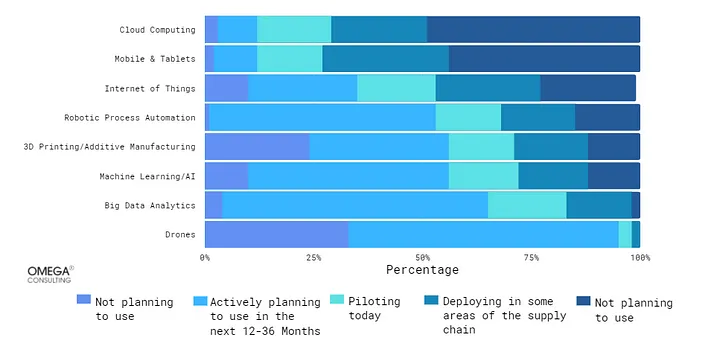- Industries
Industries
- Functions
Functions
- Insights
Insights
- Careers
Careers
- About Us
- Technology
- By Omega Team

Supply chain management is the administration of the entire production flow of a commodity or service, beginning with the raw materials and delivering the finished product to the consumer. A company establishes a network of suppliers (connecting links in the chain) that transport the product from the supplier to the organizations that interact directly with end consumers.
What is a Digital Supply Chain?
A digital supply chain uses data analytics and digital technology to help with decision-making, boost efficiency, and adapt swiftly to shifting demands. Data generated by current supply networks are the lifeblood of digital supply chains; this data is collected in data warehouses and analyzed to provide insights that can be put into practice. The value of digital technology and experts in supply chain management rises in tandem with the significance of these networks in the on-time delivery of products and services.Traditional Supply Chain vs. Digital Supply Chain
Traditional Supply chains have historically followed a straight path from raw material procurement to production, distribution, and retail. Delays in one segment of the entire supply chain may have a domino effect on other parts, increasing costs. Each stage requires evaluation and planning, both vulnerable to delays. A digital supply chain generates data at each stage and is used for strategic planning and developing dynamic outputs during delays.
Digital supply networks are enabled by a constant flow of real-time data, allowing for more effectively controlled transportation and logistics. In contrast, a lack of actionable information typically slows down conventional supply chains.
Exhibit 1: Traditional Supply Chain
For a Traditional supply chain, the information travels in a step-by-step sequential manner — from develop to support.

Exhibit 2: Digital Supply Chain Network
They overcome the delayed action–reaction process of the linear supply chain by utilizing real-time data to improve decision-making.


7 Steps to Implement Digital Supply Chain
Digital transformation does not follow a single path. But fundamental stages include posing one question: How can data be used to solve problems? It can be solved by following seven simple steps, which are as follows:
1. Ensure you have the basics right: Ensure the fundamentals are in order before implementing new technology. Determine the necessary process enhancements if your current supply chain structure has performance issues.
2. Bring disparate functions together: Do not conceive in terms of discrete functions such as purchasing and production. Concentrate on how various stakeholders accomplish the intended business result. Consider surveying to determine requirements and gauge awareness.
3. Define business objectives beyond operational efficiency: Examples include enhanced demand planning. A digital supply chain can provide a clearer picture of the relationship between unprocessed materials and finished goods.
4. Get everyone on board: Define the supply chain strategy and ensure it is communicated to all levels of the organization, right from the executive level to the shop floor. On the technology side, when assembling cross-functional teams, preference should be given to an agile development methodology (one that seeks to accomplish bite-sized objectives for teams working towards a larger goal).
5. Inventory your data: Consider the supply chain data already collected by the organization and how it can be expanded. Rather than manually calculating safeguard stock, for instance, using an algorithm to accurately forecast needs.
6. Look outward: Examine what information your suppliers can share automatically through IoT and APIs and what information you can share with them.
7. Prioritize projects: For this step, examples are using predictive analytics for demand planning, more dependable order processing, logistics planning, warehouse automation, improved end-to-end transparency and real-time response to disruptions. Implementing these seven steps, where data can be used to solve problems and form the core of a digital transformation. In a Digital supply chain quantitative, qualitative, and innovative data is effectively used to solve the issues present in the current supply chain models.Exhibit 3: 7 Steps to Implement Digital Supply Chain
The following are the fundamental steps to implement a digital transformation process which can also be extended to the Digital Supply Chain.

Market Opportunities for Digital Supply Chain
Using cutting-edge digital technology, businesses may completely revamp their supply chain management. There has been an upscale in the practice of “digital transformation” among companies, which uses analytics, robotics, AI, the IoT, and other cutting-edge technologies to automate or streamline data collection and processing, decision-making, and other tasks. The need for digital transformation in the supply chain has increased to boost supply chain performance across the board, including service, agility, cost, and inventory. Therefore, the current digital transformation trend presents an excellent opportunity to expand the digital supply chain market. The anticipated numbers for the future market provide an excellent opportunity for businesses to implement, grow and transform the supply chain Industry.
Exhibit 4: Projected values of the Digital Supply Chain Industry
It is anticipated that digital supply chains will grow in the future years. For Instance, the worldwide digital supply chain industry is expected to be worth $13.7 billion by 2030, up from an estimated $3.9 billion in 2020.

Exhibit 5: Percentage Implementation of different Technologies
The survey of 212 supply chain leaders from diverse industries and company sizes demonstrates that technological capabilities are both present and imminent. Currently, IoT, mobile, cloud, and 3D printing is widespread, and many businesses plan to incorporate big data analytics, robotic process automation, drones, and machine learning, within the next three years.

Impact of COVID-19 on Global Digital Supply Chain
With a CAGR of 13.2% between 2020 and 2030, the worldwide digital supply chain market is expected to grow from its 2020 valuation of $3.9 billion million to $13.7 billion. Current projections for 2030 are anticipated to rise beyond those made before COVID-19. Due to the rising trend toward digitalization, the COVID-19 Pandemic has considerably boosted the market’s growth pace. Companies in the manufacturing, food, beverages, and logistics sectors must increase their investment in automation due to rising consumer demand for online shopping, including the automation and digitalization of supply chains, further expanding the market for digital supply chains. By increase in the investment companies can meet the ongoing demand that is currently present in the market post COVID-19 and digitalization is a way forward for companies to keep growing and meet the consumer demand.
A lot of sectors are hit hard by this pandemic, making it harder for them to manage their extensive supply chain networks, which is projected to increase demand for digital supply chain solutions. For example, a March 2020 survey by the “Institute for Supply Chain Management Organization” found that nearly 75% of companies had experienced disruptions to their global supply chains due to coronavirus-related transportation restrictions.
Advantages of using a Digital Supply chain
SpeedIn the digital supply chain, new approaches to product distribution can reduce the delivery time for many products to a few hours. Utilizing advanced forecasting techniques such as predictive analysis, digital supply chains provide significantly more accurate consumer demand forecasts. In contrast to monthly forecasting, digital supply chains conduct weekly and sometimes daily forecasting for products with a rapid turnover rate.
Adaptability
Real-time supply chain planning enables businesses to respond more quickly to fluctuating demand or supply conditions. By reducing planning cycles, digital supply chains make the planning process more continuous and adaptable to changing requirements or constraints.
Granularity
As the demand for more individualized products grows, there is a strong drive towards micro-segmentation and mass customization. Digital supply chains enable businesses to manage clients in much more granular clusters and allow customers to choose offerings that precisely meet their requirements. Consider drone delivery and the potential to personalize the consumer experience throughout the supply chain.
Precision
Digital supply channels offer end-to-end, real-time visibility throughout the supply chain. The information produced ranges from high-level KPIs to granular process data, and this spectrum provides a common information foundation for all levels of seniority and supply chain stakeholders.
Efficiency
Automation of both physical duties and planning increases supply chain efficiency. In a digital supply chain, for instance, robots manage the material throughout the warehouse process, from receiving and offloading to storing to selecting, packaging, and dispatching. With all these advantages that a digital supply chain has, new technologies and dependability on the Internet can also expose businesses to unknown risks.
Concerns Associated with the Digital Supply Chain
As supply chains become digital, professionals must be aware of the hazards. Digital supply chains face two significant risks:
Cybersecurity
Data and automation make digital supply chains vulnerable, which may jeopardize systems and user data. Cyber security experts, on the other hand, can help prepare strategies to fight off the threats.
Unprepared professionals
McKinsey & Company found that approximately 70% of digital transformation programs fail due to staff needing more expertise to use new technologies.
Future Outlook
The Fourth Industrial Revolution is reshaping every stage of the supply chain. New technologies like cloud computing, analytics, IoT, artificial intelligence, machine learning, and others are being integrated into manufacturing processes and facilities. Modern sensors, embedded software, and robotics in these intelligent factories aggregate and analyze data for better decision-making. New visibility and insight are developed from old data when data from manufacturing activities are used along with operational data from ERP, supply chain, customer service, and other business systems. Supply Chain 4.0 is a realistic goal in light of all these developments. Using the IoT, advanced robotics, and big data analytics, digital Supply Chain aims to enhance significantly supply chain performance and customer satisfaction by placing sensors in everything, creating networks everywhere, automating everything, and analyzing everything.
Conclusion
It is an amazing opportunity to witness the transformation of the Supply Chain. There will be phenomenal opportunities to shape and engage in the transition to a world with a Digital Supply Chain due to the adaptation of technologies. In reality, most businesses will continue to integrate analog technologies into their Supply Chains. Implementing the Digital Supply Chain will require considerable time for most companies, so we can still imagine the future to be digitized for excellence.
Subscribe
Select topics and stay current with our latest insights
- Functions